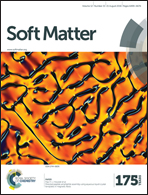Chiral oily streaks in a smectic-A liquid crystal
Abstract
The liquid crystal octylcyanobiphenyl (8CB) was doped with the chiral agent CB15 and spin-coated onto a substrate treated for planar alignment of the director, resulting in a film of thickness several hundred nm in the smectic-A phase. In both doped and undoped samples, the competing boundary conditions – planar alignment at the substrate and vertical alignment at the free surface – cause the liquid crystal to break into a series of flattened hemicylinders to satisfy the boundary conditions. When viewed under an optical microscope with crossed polarizers, this structure results in a series of dark and light stripes (“oily streaks”) of period ∼1 μm. In the absence of chiral dopant the stripes run perpendicular to the substrate's easy axis. However, when doped with chiral CB15 at concentrations up to c = 4 wt%, the stripe orientation rotates by a temperature-dependent angle φ with respect to the c = 0 stripe orientation, where φ increases monotonically with c. φ is largest just below the nematic – smectic-A transition temperature TNA and decreases with decreasing temperature. As the temperature is lowered, φ relaxes to a steady-state orientation close to zero within ∼1 °C of TNA. We suggest that the rotation phenomenon is a manifestation of the surface electroclinic effect: The rotation is due to the weak smectic order parameter and resulting large director tilt susceptibility with respect to the smectic layer normal near TNA, in conjunction with an effective surface electric field due to polar interactions between the liquid crystal and substrate.


 Please wait while we load your content...
Please wait while we load your content...